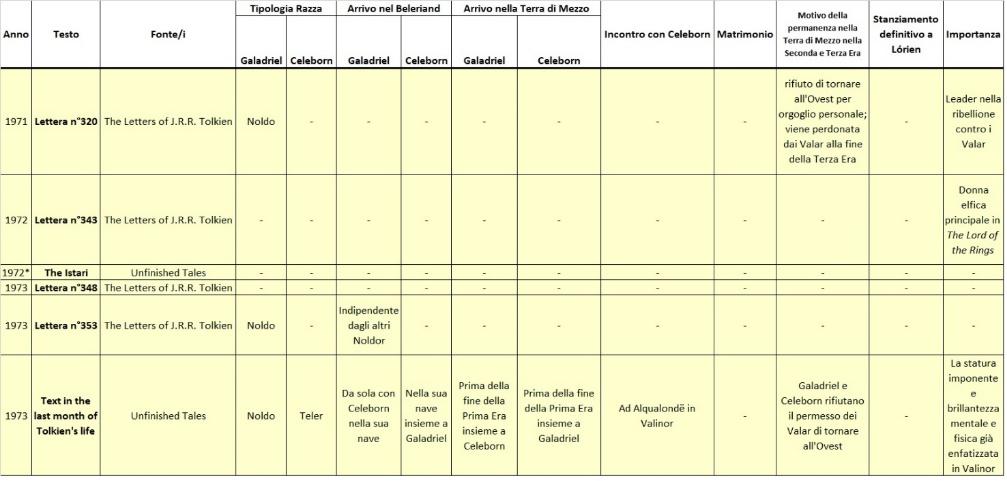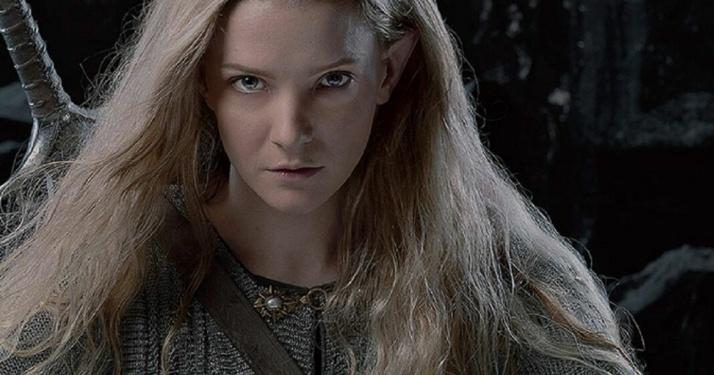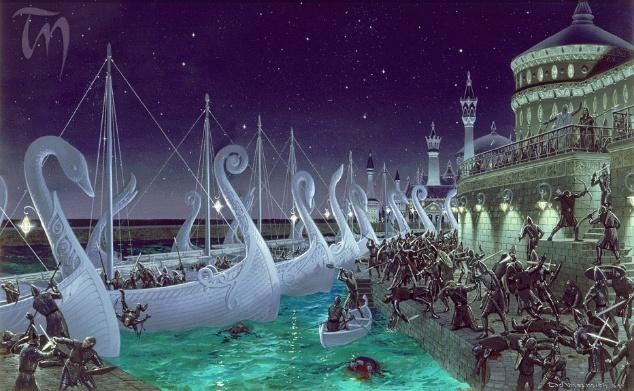di Benedetto Ardini
L’ultimo periodo (1970-1973)
TESTI TRATTATI IN QUESTA SEZIONE
(* anno indicativo ? elemento non chiaro – elemento non presente nel testo)

CONCETTO CHIAVE: Galadriel viene resa indipendente dagli altri Noldor nell’arrivo del Beleriand ed enfatizzata nella sua statura già nel Reame Beato
Dato che il Silmarillion non era ancora stato pubblicato e quindi non esisteva ancora una forma definitiva del corpus di testi della mitologia tolkieniana, nell’ultima parte della sua vita Tolkien continuò a sviluppare il personaggio di Galadriel introducendo ulteriori e radicali cambiamenti nella sua storia nei Tempi Remoti.
In una lettera del 1971 Tolkien sembra ancora ritornare sul concetto del “divieto” su Galadriel: questa volta non una condanna irrevocabile che, partendo dalla Prima Era, si estende fino alla fine della Terza, ma il fatto che Galadriel, rifiutatasi di tornare all’Ovest quando permesso dai Valar dopo la Caduta di Morgoth, si sia ridotta ad essere una ‘penitente’ che può tornare sui suoi passi solo dopo aver ottenuto il perdono (che otterrà solo alla fine della Terza Era grazie alla resistenza finale alla tentazione di prendere l’Unico Anello per sé127). In questo senso possiamo dire che un divieto esiste ma non perché sia un’estensione della condanna sui Noldor Ribelli (introdotta nella Prima Era e confermata per la Seconda e la Terza) piuttosto perché i Valar sono “offesi” dal rifiuto dell’Elfa alla loro offerta (a cavallo tra la Prima e la Seconda Era) e quindi un perdono diventa necessario128.
In una lettera del 1972 Tolkien ribadisce che Galadriel è la donna elfica più importante di The Lord of the Rings129. In un testo dello stesso anno130 sugli Istari Tolkien ci dà ragione del perché Galadriel, che viene descritta come forte di corpo e mente nello Shibboleth of Fëanor, in The Lord of the Rings assuma un atteggiamento più di difesa, resistenza e saggezza: Galadriel (così come gli altri Elfi) non coinvolti nel centro dell’azione contro Sauron. Questo è perfettamente in accordo con il concetto del Passo del Fato espresso dalla stessa Galadriel in The Fellowship of the Ring per cui, in un modo o nell’altro, gli Elfi sono destinati a svanire, sia se Sauron riconquista l’Anello sia se l’Anello viene distrutto: l’unico modo che Galadriel avrebbe di sfuggire a questo Passo è prendere l’Unico Anello per sé131. Questo spiega perché sia Gandalf, e non Galadriel, l’oppositore principale del Nemico nella Terza Era132.
A proposito dell’azione, in una lettera del 1973 Tolkien ci parla proprio dell’atleticità di Galadriel nella sua ‘giovinezza’133 definendola come un’amazzone134.

Molto interessante è un’altra lettera del 1973135 che anticipa un cambiamento radicale nella storia di Galadriel nella Prima Era che Tolkien scriverà nell’ultimo testo della sua vita.
In questa lettera viene ribadita e stressata la contrapposizione di Galadriel a Fëanor (già delineata nello Shibboleth of Fëanor) e l’idea che lei sia ‘senza macchia’ per quanto riguarda le azioni crudeli dei Noldor nel Fratricidio di Alqualondë. L’elemento innovativo è che Galadriel giunge nel Beleriand dall’Ovest indipendentemente da Fëanor e gli altri Noldor136.
Questo concetto ci porta quindi all’ultimo testo su Valinor e la Terra di Mezzo scritto nell’ultimo mese di vita da Tolkien137. Tale testo, oltre che riprendere quanto scritto nella lettera a riguardo dell’opposizione di Galadriel a Fëanor e l’arrivo nella Terra di Mezzo indipendente dagli altri Noldor, ci da i seguenti dettagli138:
- nel Reame Beato Galadriel va a dimorare ad Alqualondë dove incontra Celeborn (che quindi è considerato un principe dei Teleri in accordo con lo Shibboleth of Fëanor) e che insieme pianificano di salpare per la Terra di Mezzo;
- Galadriel e Celeborn combattono contro Fëanor nel Fratricidio di Alqualondë e che la nave di Celeborn si salva;
- con la nave i due raggiungono il Beleriand indipendentemente dai Noldor;
- Galadriel e Celeborn non prendono parte alla guerra contro Morgoth;
- lasciano il Beleriand superando gli Ered Lindon prima della fine della Prima Era e quando ricevono il permesso di tornare all’Ovest rifiutano.

Di rilevanza è il fatto che Galadriel viene detta essere ‘brillante di mente e rapida in azione’ e che, proprio per questo motivo, lei desiderava lasciare il Reame Beato ed esercitare i propri talenti nella Terra di Mezzo139: questo enfatizza la statura imponente di Galadriel già in Valinor140.
Nonostante la peculiarità di questo scritto, Christopher Tolkien ci dice di non averlo utilizzato per la composizione del Silmarillion perché questo avrebbe richiesto uno stravolgimento non indifferente della narrativa e inoltre perché, a suo avviso, questo ultimo testo ha un carattere più filosofico che storico nell’evoluzione di Galadriel141.
A questo punto della vita di J.R.R. Tolkien il Silmarillion non era stato ancora pubblicato e quindi avrebbe potuto applicare ancora molti cambiamenti alla storia di Galadriel. Tuttavia a questo punto il Professore se ne andò da questo mondo e purtroppo l’enorme materiale sulla storia di Galadriel non venne mai fissato in una versione definitiva per la pubblicazione: il lettore, a questo punto, può avere il piacere di considerare una varietà di “tradizioni” e immaginarsi di essere uno storico che consulta diverse fonti prima di figurarsi un evento antico142.
Conclusioni
In questo articolo abbiamo visto lo sviluppo del personaggio di Galadriel all’interno della mitologia tolkieniana con un approccio cronologico. Abbiamo individuato 7 periodi interessanti di tale evoluzione che ci hanno permesso di apprezzare meglio gli aspetti peculiari di ciascun momento nella creazione progressiva del personaggio.
Abbiamo visto l’importanza di Galadriel in The Lord of the Rings per la definizione del background mitologico della storia (Seconda Era e Anelli del Potere), il suo inserimento in tradizioni leggendarie già delineate da Tolkien molto tempo prima (Annals e Quenta Silmarillion), la sua espansione nella Seconda Era, i conti di Tolkien sulle sue età e la riflessione sulla “maturità”, il concetto del divieto dei Valar (emerso ad un certo punto ma poi ritirato) e l’esaltazione dei caratteri fisici e mentali dell’Elfa.
La varietà dei testi sulla storia di Galadriel trattati ci ha fatto scontrare con quello che probabilmente è la parte più complessa della creazione tolkieniana: abbiamo almeno un paio di versioni diverse sull’arrivo di Galadriel nel Beleriand, altrettante per il suo approdo nella terra di Mezzo, 3 tipi diversi di incontri con Celeborn, almeno 4 diverse ragioni per cui Galadriel rimane nella Seconda e nella Terza Era nella Terra di Mezzo, 3 diversi momenti per il suo stanziamento definitivo a Lórien ecc… Tuttavia una cosa è certa: la sempre più crescente importanza data da Tolkien alla Signora Elfica sia nella Terra di Mezzo che nel Reame Beato.
TABELLA COMPLESSIVA DEI TESTI
127“[…] actually Galadriel was a penitent: in her youth a leader in the rebellion against the Valar (the angelic guardians). At the end of the First Age she proudly refused forgiveness or permission to return. She was pardoned because of her resistance to the final and overwhelming temptation to take the Ring for herself.” (Humphrey Carpenter, The Letters of J.R.R. Tolkien, letter n°320)
128Questa affermazione può essere supportata confrontando le lettere 297 (in cui era presente il concetto del divieto alla fine della Prima Era) e la 320 in esame (in cui sembra esserci un divieto per il fatto che Galadriel debba essere perdonata). Si confrontino in particolare i passaggi finali nelle due lettere: “Her prayer was granted – but also her personal ban was lifted, in reward for her services against Sauron, and above all for her rejection of the temptation to take the Ring when offered to her. So at the end we see her taking ship.” (Humphrey Carpenter, The Letters of J.R.R. Tolkien, letter n°297) e “She was pardoned because of her resistance to the final and overwhelming temptation to take the Ring for herself.” (Humphrey Carpenter, The Letters of J.R.R. Tolkien, letter n°320). Si confrontino questi passaggi con lo Shibboleth of Fëanor dove invece il concetto del perdono dei Valar alla fine della Terza Era non è presente o comunque non esplicito: “[…] at the end of the Elder Days after the final overthrow of Morgoth, she refused the pardon of the Valar for all who had fought against him, and remained in Middle-earth. It was not until two long ages more had passed, when at last all that she had desired in her youth came to her hand, the Ring of Power and the dominion of Middle-earth of which she had dreamed, that her wisdom was full grown and she rejected it, and passing the last test departed from Middle-earth for ever.” (The History of Middle-earth, vol.12, The Peoples of Middle-earth, Part Two: Late Writings, ch. XI The Shibboleth of Fëanor, pag.481, Ebook Edition © December 2022 ISBN: 9780007348299). Nello Shibboleth of Fëanor sembrerebbe la volontà di Galadriel che la spinge a rimanere nella Terra di Mezzo e non un divieto. Questo è in accordo con quanto dice a Frodo dopo aver superato la tentazione dell’Anello ovvero che andrà all’Ovest come scelta (quindi non c’è un divieto): “‘I pass the test,’ she said. ‘I will diminish, and go into the West, and remain Galadriel.’” (J.R.R. Tolkien, The Lord of the Rings, The Fellowship of the Ring, book 2, ch.7 The Mirror of Galadriel, pag.366, Ebook Edition © August 2022 ISBN: 9780007322596).
129“Galadriel (‘Glittering garland’) is the chief elvish woman mentioned in The Lord of the Rings […]” (Humphrey Carpenter, The Letters of J.R.R. Tolkien, letter n°343)
130Questo testo riguarda gli Istari ed è stato pubblicato in Unfinished Tales da Christopher Tolkien: “I know of no other writings about the Istari save some very rough and in part uninterpretable notes that are certainly much later than any of the foregoing, and probably date from 1972 […]” (Unfinished Tales, Part Four, ch. II The Istari, pag.377, Edition 1998)
131Questo è evidente dalle parole di Galadriel a Frodo in The Fellowship of the Ring: “Do you not see now wherefore your coming is to us as the footstep of Doom? For if you fail, then we are laid bare to the Enemy. Yet if you succeed, then our power is diminished, and Lothlórien will fade, and the tides of Time will sweep it away.” (J.R.R. Tolkien, The Lord of the Rings, The Fellowship of the Ring, book 2, ch.7 The Mirror of Galadriel, pag.365, Ebook Edition © August 2022 ISBN: 9780007322596).
132“In Sauron’s final overthrow, Elves were not effectively concerned at the point of action. Legolas probably achieved least of the Nine Walkers. Galadriel, the greatest of the Eldar surviving in Middle-earth, was potent mainly in wisdom and goodness, as a director or counsellor in the struggle, unconquerable in resistance (especially in mind and spirit) but incapable of punitive action. In her scale she had become like Manwë with regard to the greater total action. Manwë, however, even after the Downfall of Númenor and the breaking of the old world, even in the Third Age when the Blessed Realm had been removed from the ‘Circles of the World’, was still not a mere observer. It is clearly from Valinor that the emissaries came who were called the Istari (or Wizards), and among them Gandalf, who proved to be the director and coordinator both of attack and defence.” (Unfinished Tales, Part Four, ch. II The Istari, pag.378, Edition 1998)
133In questo caso, alla luce di quanto sottolineato nel testo sugli Istari dove viene sottolineato l’atteggiamento sommesso di Galadriel in The Lord of the Rings, è probabile che ‘giovinezza’ sia in riferimento ad un periodo nella mitologia precedente alla Terza Era e non nel senso indicato in Elvish Ages & Númenórean
134“Galadriel, like all the other names of elvish persons in The Lord of the Rings, is an invention of my own. It is in Sindarin form (see Appendices E and F) and means ‘Maiden crowned with gleaming hair’. It is a secondary name given to her in her youth in the far past because she had long hair which glistened like gold but was also shot with silver. She was then of Amazon disposition and bound up her hair as a crown when taking part in athletic feats.” (Humphrey Carpenter, The Letters of J.R.R. Tolkien, letter n°348)
135“Galadriel was ‘unstained’: she had committed no evil deeds. She was an enemy of Fëanor. She did not reach Middle-earth with the other Noldor, but independently. Her reasons for desiring to go to Middle-earth were legitimate, and she would have been permitted to depart, but for the misfortune that before she set out the revolt of Fëanor broke out, and she became involved in the desperate measures of Manwe, and the ban on all emigration.” (Humphrey Carpenter, The Letters of J.R.R. Tolkien, letter n°353)
136“Galadriel was ‘unstained’: she had committed no evil deeds. She was an enemy of Fëanor. She did not reach Middle-earth with the other Noldor, but independently. Her reasons for desiring to go to Middle-earth were legitimate, and she would have been permitted to depart, but for the misfortune that before she set out the revolt of Fëanor broke out, and she became involved in the desperate measures of Manwe, and the ban on all emigration.” (Humphrey Carpenter, The Letters of J.R.R. Tolkien, letter n°353)
137“A wholly different story, adumbrated but never told, of Galadriel’s conduct at the time of the rebellion of the Noldor appears in a very late and partly illegible note: the last writing of my father’s on the subject of Galadriel and Celeborn, and probably the last on Middle-earth and Valinor, set down in the last month of his life.” (Unfinished Tales, Part Two, ch. IV The History of Galadriel and Celeborn, pag.223, Edition 1998)
138Si veda Unfinished Tales, Part Two, ch. IV The History of Galadriel and Celeborn, pag.223-224, Edition 1998
139“She did indeed wish to depart from Valinor and to go into the wide world of Middle-earth for the exercise of her talents; for ‘being brilliant in mind and swift in action she had early absorbed all of what she was capable of the teaching which the Valar thought fit to give the Eldar’, and she felt confined in the tutelage of Aman.” (Unfinished Tales, Part Two, ch. IV The History of Galadriel and Celeborn, pag.223, Edition 1998)
140“In this he emphasized the commanding stature of Galadriel already in Valinor, the equal if unlike in endowments of Fëanor” (Unfinished Tales, Part Two, ch. IV The History of Galadriel and Celeborn, pag.223, Edition 1998)
141“This story […] is profoundly at variance with all that is said elsewhere. It arose from ‘philosophical’ (rather than ‘historical’) considerations, concerning the precise nature of Galadriel’s disobedience in Valinor on the one hand, and her status and power in Middle-earth on the other. That it would have entailed a good deal of alteration in the narrative of The Silmarillion is evident; but that my father doubtless intended to do. It may be noted here that Galadriel did not appear in the original story of the rebellion and flight of the Noldor, which existed long before she did; and also, of course, that after her entry into the stories of the First Age her actions could still be transformed radically, since The Silmarillion had not been published. The book as published was however formed from completed narratives, and I could not take into account merely projected revisions.” (Unfinished Tales, Part Two, ch. IV The History of Galadriel and Celeborn, pag.224, Edition 1998)
142Afferma infatti Christopher Tolkien riferendosi al processo creativo del padre: “Divergent versions need not indeed always be treated solely as a question of settling the priority of composition; and my father as ‘author’ or ‘inventor’ cannot always in these matters be distinguished from the ‘recorder’ of ancient traditions handed down in diverse forms among different peoples through long ages” (Unfinished Tales, Introduction, pag.10, Edition 1998)
Laureato in Ingegneria Fisica al Politecnico di Milano dove sta proseguendo la sua carriera come PhD. Fin da bambino è appassionato di Tolkien i cui libri rappresentano per lui uno stimolo e un accompagnamento fondamentali per la vita di tutti i giorni.



